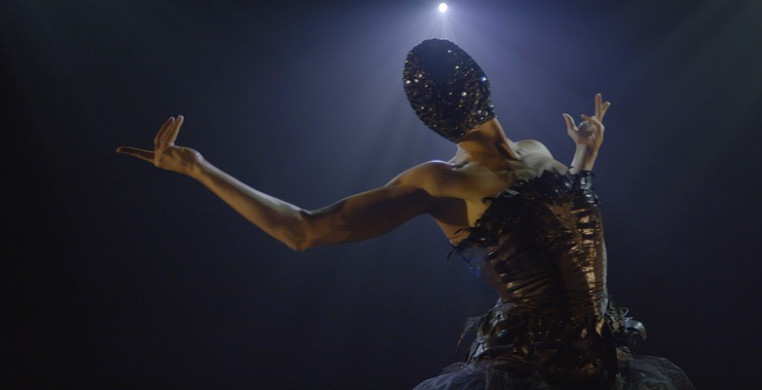With Halloween upon us, the season of the witch is alive and well in the newest work by Nejla Yatkin, “The Other Witch,” at the Ruth Page Center for the Arts on November 9th, at 7 pm. Yatkin invited SeeChicagoDance to a run-through of the work at Links Hall, alongside her dramaturge Susan Manning, videographer Enki Andrews and assistant Chloe Bigelow.
Reimagining Mary Wigman’s iconic “Hexentanz” (or “Witch Dance”) through a contemporary lens, Yatkin evolves Wigman’s masked witch into a new creature. While paying homage to the original with specific choreographic moments that would only be known to those familiar with the precedent work, she infuses her movement vocabulary with contemporary themes and cultural stigmas. The striking choreography, paired with a haunting score by composer Shamou, by Yatkin embodies the tension between liberation and societal constraints, transforming the stage into a realm of magic and introspection—Yatkin dedicates this performance to the recently deceased Shamou to honor his memory.
Yatkin invites her audience into a space void of time or place where the breath of the past and modern ideas collide. Lighting design by Jacob Snodgrass is the focal point in Yatkin’s thoughtful piece as her body emerges and disappears through shadow and light. For the first half a black shroud obscures her body until it fully emerges like a butterfly from its cocoon, shedding its worn and tired skin to breathe life into a new being.
Her choreography embraces the raw energy and emotional depth of Wigman’s original work while infusing it with her unique perspective, drawing from her heritage and experience. The performance becomes a vivid tapestry of swirling movements and striking visuals, calling the audience to witness the reclamation of the witch archetype.
 “The Other Witch”, with Nejla Yatkin;Photo by Enki Andrews
“The Other Witch”, with Nejla Yatkin;Photo by Enki Andrews
Complementing this thoughtful choreography, Yatkin's costume embodies a striking duality. Yatkin begins the the work huddled underneath an immense black fabric, then she emerges in a flowing black tulle skirt that whispers secrets with every movement. The intricately decorated black corset accentuates her elegance and power. While the silhouette of the ensemble evokes the stereotypical witch look, the full black rhinestoned head mask conceals her identity, reflecting light in mesmerizing patterns and emphasizing the theme of the "other." Designed by Jordan Ross, this ensemble visually represents hidden truths and dual identities, creating an unforgettable image of enchantment and enigma.
Wigman’s “Witch Dance,” a pioneering expressionist piece from 1914, emerged in a tumultuous social climate. It explores primal energy and the supernatural, with evocative movements channeling the spirit of the witch. Wigman's innovative use of space, music, and costume—such as a cloak and a Japanese Noh theater mask—challenges traditional femininity, reflecting her belief in dance as a transformative means of self-expression.
The early 20th century, characterized by a vibrant yet turbulent artistic landscape, saw the rise of expressionism as artists sought to break free from conventional norms and delve into deeper emotional and psychological truths. The tensions of rapid industrialization, societal change, and the impending war fostered a sense of urgency and experimentation in the arts, which Wigman’s work encapsulates.
 “The Other Witch”, with Nejla Yatkin;Photo by Enki Andrews
“The Other Witch”, with Nejla Yatkin;Photo by Enki Andrews
Yatkin's "The Other Witch" resonates with contemporary anxieties and the complexities of modern life, mirroring Wigman’s original response to its time. While Wigman addressed the urgency of war, Yatkin’s choreography speaks to the chaos of a digital age filled with misinformation and division. Both works embody innovation and challenge societal norms, yet they reflect their respective eras' struggles: Wigman’s exploration of primal forces versus Yatkin’s commentary on disconnection and confusion in today’s fragmented information landscape. This artistic dialogue highlights how each artist captures cultural unrest and navigates systemic issues that shape audience experiences.
Through "The Other Witch," Yatkin not only honors Wigman’s legacy but also challenges notions of the “other” and femininity. She offers a powerful commentary on politics, culture and the feminine experience, encouraging viewers to rethink their perceptions of the witch and feminine identities. This compelling performance promises to leave audiences spellbound with its illumination of the enduring strength and resilience of women throughout time. Don’t miss this opportunity to experience a unique artistic exploration that promises to resonate long after the curtain falls.
"The Other Witch" is presented by Nejla Yatkin at the Ruth Page Center for the Arts on Nov. 9th. Showtime is 7pm, followed by a discussion with dramaturge and dance historian Susan Manning. Tickets are $25 available at ny2dance.com or the Ruth Page Center box office.
Happy Halloween from all of us at SeeChicagoDance!

